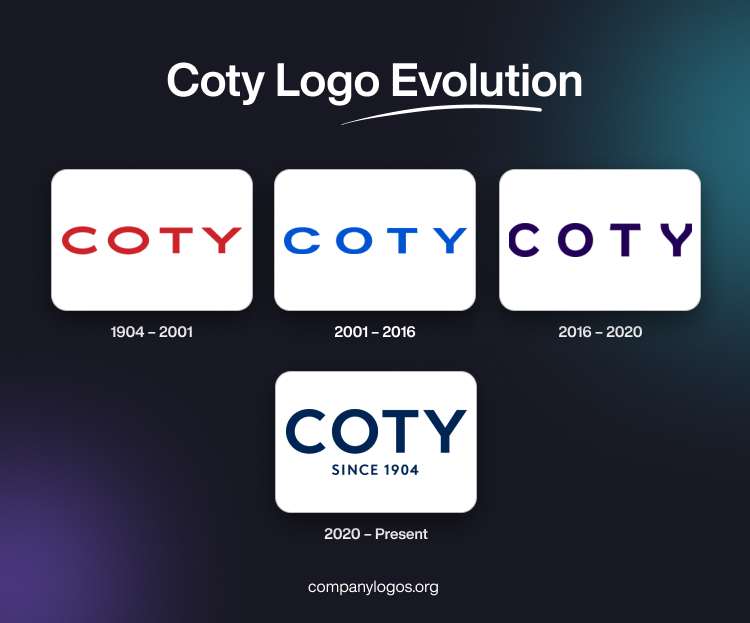
The famous cosmetics brand Coty Inc. was founded in 1904 in Paris by a young French perfumer named François Coty (born Joseph Marie François Spoturno). The logo of this brand has undergone a few changes, which reflect the company’s growth, changing values, and its commitment to innovation and inclusivity. The article explores the evolution of the Coty logo through various timelines.
The Genesis of the Coty Logo (1904 – 2001)
The original Coty logo was designed to evoke elegance and sophistication. Designed in 1904, the logo remained for nearly a century. The minimalist and slightly stretched logotype featured “COTY” in red uppercase and in a serif typeface. There was adequate spacing between the letters to ensure greater visibility.

(2001 – 2016)
The first logo change was carried out in 2001 by changing the typeface and colour of the logotype. The new design featured slightly compact letters in blue. However, the spacing between the letters was retained for enhanced visibility.

(2016 – 2020)
In 2016, Coty underwent one of its most significant rebranding efforts led by Workroom, a London-based branding consultancy. The new logo incorporated a bespoke font in deep purple with a curvy “Y”. It symbolised symmetry similar to butterfly wings—a motif chosen to represent change, beauty, and diversity. The butterfly-inspired design reflected Coty’s areas of specialisation: fragrance, hair care, and colour cosmetics.

(2020 – Present)
The logo has become an emblem of transformation within both the company and the beauty industry at large. It features the brand name in deep blue and in a bigger size. Below the brand name was mentioned its year of inception, “SINCE 1904”, in a smaller size, but in the same colour scheme.

The Elements of the Coty Logo
Font
The Coty logo features a bespoke typeface, which is minimalist and clean, with rounded edges that convey elegance and approachability.
The standout feature is the curvy “Y”, which resembles butterfly wings—a symbol of transformation, beauty, and diversity. This unique design element adds visual interest while reinforcing Coty’s focus on inclusivity and innovation.
Colour
The logo primarily uses vibrant colours in its modern iterations to reflect the diversity and creativity of the beauty industry. The logotypes appear in full-colour versions comprising red, blue, purple, and deep blue. These variations ensure adaptability across digital, print, and embroidery formats. The choice of colours in the Coty logo aligns with its mission to celebrate individuality and self-expression. Vibrant hues are often inspired by materials from its product portfolio, such as cosmetics and fragrances.
The History of Coty
Coty was founded in 1904 in Paris by a young French perfumer named François Coty, who was born as Joseph Marie François Spoturno in Corsica. Coty had a keen sense for fragrance and a revolutionary vision for how perfumes should be marketed and sold.
At the time, perfumes were mainly sold as luxury goods, reserved for the wealthy. Coty aimed to create high-quality scents that were also affordable to a broader audience. He crafted his first fragrance, La Rose Jacqueminot, which became an instant success after he cleverly smashed a sample bottle on the sales floor of the Grands Magasins du Louvre (one of Paris’s major department stores). The smashed bottle of scent let out the fragrance to waft through the store and entice customers.
A large part of Coty’s early success came from his collaboration with artists like René Lalique. The latter was the famous Art Nouveau glassmaker, who designed beautiful, innovative bottles for Coty fragrances. These artful, accessible packages made Coty’s products desirable for a wide range of consumers. By the 1920s, Coty had become a massive name in the beauty world. The company expanded into face powders, lipsticks, and other cosmetics. It combined its fragrances with beauty products to create a broader lifestyle brand.
François Coty was not just a master perfumer but also a shrewd businessman. He invested heavily in advertising and was among the first to create coordinated product lines that matched a perfume with complementary cosmetics and creams. His innovative marketing strategies helped Coty become one of the first truly global beauty brands, with factories in the U.S. and subsidiaries throughout Europe.
However, Coty’s personal life grew increasingly turbulent. He became involved in politics and owned the influential newspaper Le Figaro and ran for public office. His later years were marked by financial mismanagement and personal challenges. François Coty died in 1934, and after his death, the company entered a period of significant transition.
After the passing of Coty, the company changed hands several times. In the 1960s, Coty was purchased by Chas. Pfizer & Co., the pharmaceutical giant now known simply as Pfizer. In fact, Pfizer saw great value in Coty’s established brand reputation as it wanted to diversify into consumer goods.
Under Pfizer’s ownership, Coty continued to develop new fragrances and cosmetics but struggled somewhat to maintain the glamorous image built under the leadership of François Coty. In the 1990s, Pfizer decided to divest from the beauty sector and sold Coty to the German consumer goods conglomerate Joh. A. Benckiser GmbH (part of what is now JAB Holding Company). This marked the beginning of a major restructuring for Coty. JAB merged Coty with other beauty assets, injected new capital, and began revitalising the brand’s product lines and marketing strategies.
One of Coty’s most transformative moves came in 2015–2016, when it acquired a substantial portion of Procter & Gamble’s beauty business for approximately $12 billion. This deal brought well-known brands like CoverGirl, Clairol, and Wella into the Coty portfolio. It also brought several prestigious fragrance licenses such as Gucci and Hugo Boss. Despite these gains, the company struggled with integrating the newly acquired brands, which led to financial turbulence and leadership changes throughout the late 2010s.
Coty also moved heavily into the celebrity fragrance market. In doing so, it partnered with stars such as Katy Perry, Lady Gaga, and later Kylie Jenner, to expand its reach into younger demographics. Entering the 2020s, Coty made strategic shifts toward premium beauty, sustainability initiatives, and digital innovation. In 2020, Coty sold a majority stake in its professional beauty division, including brands like Wella, to the private equity firm KKR. This sale was part of a broader strategy to reduce debt and focus on core categories.
Today, Coty’s business is organised mainly into two divisions: Consumer Beauty, which includes mass-market products like CoverGirl and Rimmel London, and Luxury, which features high-end fragrances and skincare products from brands such as Gucci Beauty, Burberry fragrances, and Lancaster skincare.
Interesting Facts About Coty
- In 1904, François Coty smashed a bottle of his new perfume, La Rose Jacqueminot, inside a Paris department store. The rich floral scent filled the air, attracting curious customers, which then led to his first major orders. It turned a simple shopping trip into an unforgettable sensory experience, thereby launching his career.
- Before Coty, perfume bottles were mostly plain and utilitarian. Coty believed the bottle was as important as the scent. He worked with famous glassmaker René Lalique to design stunning, artistic bottles that made owning perfume feel glamorous and collectible.
- At a time when perfumes were expensive luxuries only for the rich, Coty wanted to make high-quality fragrances affordable for the emerging middle class. He proved that beauty and elegance could — and should — be accessible to all, and not just the elite.
- In addition to running his beauty empire, Coty bought and ran the famous French newspaper Le Figaro and was deeply involved in politics during the 1920s and 1930s. He even served briefly as a mayor.
- Instead of selling just one or two perfumes, Coty introduced the idea of building a fragrance portfolio — multiple scents catering to different moods, occasions, and customer tastes. This strategy is now standard across all major fragrance brands.
- Long before the “celebrity beauty brand” boom, Coty saw the power of personal branding. Over the years, the company created or licensed perfumes for stars like Jennifer Lopez, Beyoncé, and Katy Perry. It later partnered with Kylie Jenner and Kim Kardashian to develop influencer-driven beauty lines.
- Thanks to major acquisitions, Coty controls or licenses a huge portfolio of beloved brands, including CoverGirl, Sally Hansen, Gucci Beauty, Chloé, Burberry fragrances, Wella Professionals, and more.
- In 2012, Coty made an unsolicited $10 billion offer to buy Avon Products, the direct-sales beauty giant. However, Avon declined the offer, but the bold move showed how ambitious Coty had become about expanding globally.
- In recent years, Coty has committed to sustainability and clean beauty initiatives. It has pledged to make a significant percentage of its packaging recyclable to reduce its environmental footprint. The goal of the company is to position beauty as both glamorous and responsible.
- The founder François Coty was born in Ajaccio, Corsica — the same town as Napoleon Bonaparte.
Finally
The various logo iterations of the cosmetics brand Coty represent its journey from a small fragrance house in Paris to a global beauty powerhouse. Each logo iteration reflects both aesthetic changes as well as deeper shifts in corporate values and consumer engagement strategies.